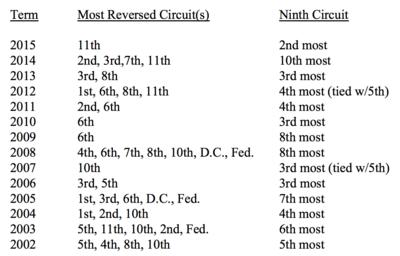The chief judge of the huge, San Francisco-based 9th Circuit Court of Appeals, under President Trump’s assault for stopping his travel ban, is pushing back on charges that it is the most overturned court in the land.
In fact, said Judge Sidney Thomas, the worst court for Supreme Court rejections is the 6th Circuit, based in Cincinnati, Ohio.

In testimony provided to a House Judiciary subcommittee, Thomas even provided a graph that proved his court in recent years hasn’t been the one with the most Supreme Court reversals.
“The record must be corrected,” said his written comments. “In recent years, the reversal rate of the Ninth Circuit has not deviated much from the rest of the circuits. It is not the most reversed circuit. Indeed, during the entire Roberts era, the most reversed circuit is the Sixth Circuit, not the Ninth,” he charged.
“The Ninth is not the most reversed circuit,” he reiterated. It was one of several charges against the court that he pushed back on.
Critics of the court regularly cite years of statistics showing that the court, which covers 11 states and territories and is often the subject of break up calls, is reversed by the Supreme Court more than any, especially in the era of more conservative Supreme Courts.
It is the court that liberals turn to to challenge conservative lower court rulings.
And it is the one that stopped Trump’s first immigration executive order and travel ban from being implemented. At a speech this week, in fact, Trump noted the calls to break up the circuit so that conservative states don’t have to see their appeals land in enemy territory.
“People are screaming break up the Ninth Circuit. I’ll tell you what … take a look at how many times they have been overturned with their terrible decisions,” said Trump.
But Thomas suggested that the better way to look at the data is to limit the window of reversals to the era of Chief Justice John Roberts. During that time, the 9th has never been the most overturned, though in 2015 it was second.
And, he added, reversal rates mean very little since a tiny percentage of the court’s appeals decisions ever make it to the Supreme Court level of consideration.
He provided his written statement to the Thursday hearing to explore breaking up the 9th. He wrote:
“Proponents of a circuit split often cite the Ninth Circuit reversal rate as a rationale for a circuit split. There is no evidence that the either the structure or size of the Ninth Circuit has any effect on reversal rate, nor any evidence that circuit size has an impact.
“First, reversal rates have nothing to do with circuit administrative performance. The Supreme Court may review anywhere between 13 and 25 cases a year out of the Ninth Circuit’s 11,000 case filings. The question of how a court would decide the merits of a handful of cases is not reflective of court administration. It is not a proper measure, under any circumstances, of whether a circuit should be structurally divided.”
During the hearing there wasn’t a wave of support for breaking the circuit up and creating a 12th. Arizona Rep. Andy Biggs, however, made the case for his state and recently introduced legislation for change.
“Today’s hearing highlighted many of the reasons why the Ninth Circuit needs to be divided into two smaller circuits. To start, it is simply too large. Twenty percent of the U.S. population resides within this circuit, twice as many as any other circuit. This delays access to justice for many Americans and creates a situation wherein citizens of the Ninth Circuit are treated differently than if they lived in any other Circuit. It is time we consider true reforms, and I believe my bill, the Judicial Administration and Improvement Act, is a good place to start.”
Paul Bedard, the Washington Examiner’s “Washington Secrets” columnist, can be contacted at [email protected]

